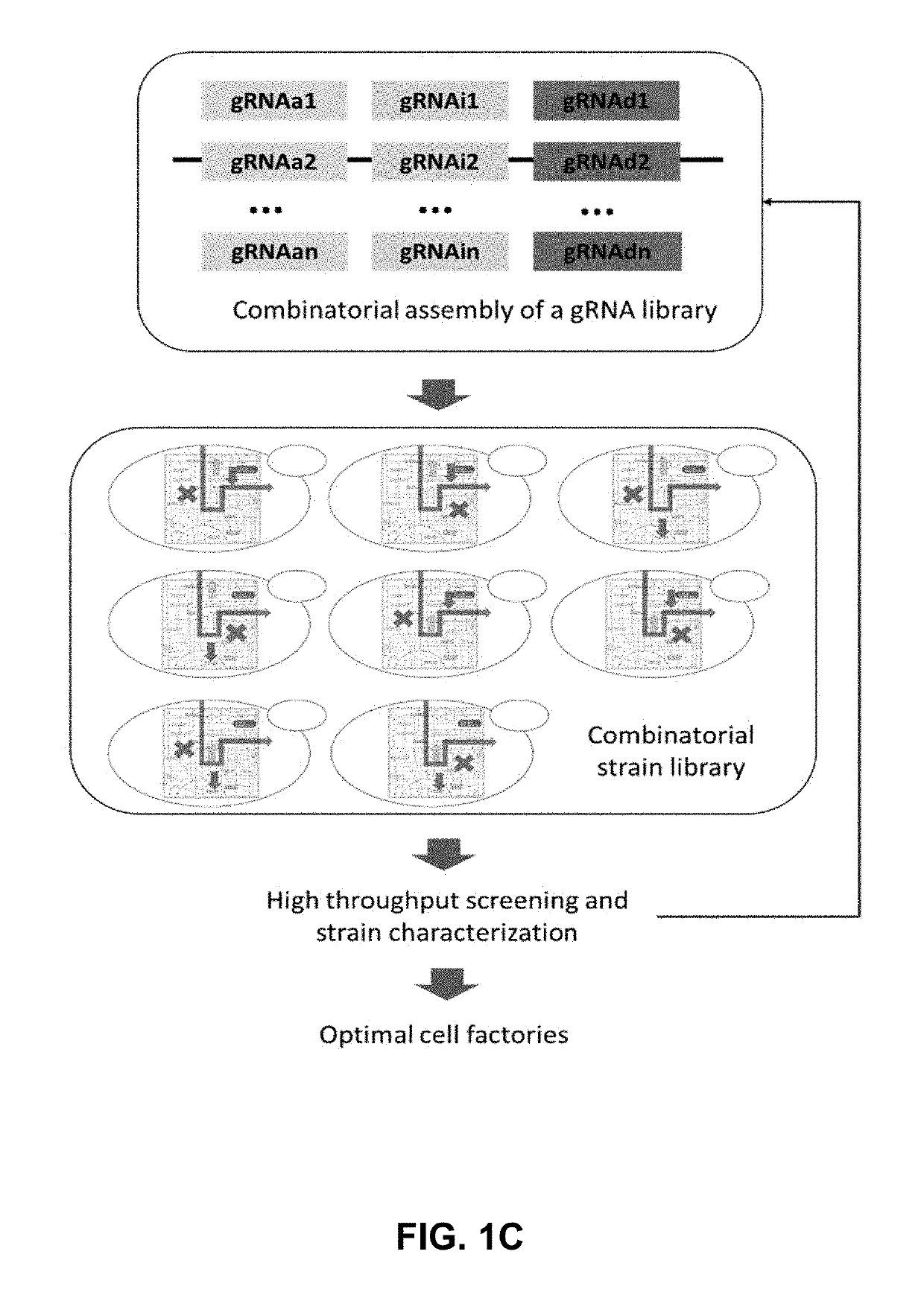Combinatorial Metabolic Engineering Using a CRISPR System
a metabolic engineering and crispr technology, applied in the field of targeted genome engineering, can solve the problems of low efficiency and throughput, low efficiency of cellular metabolism rewiring, labor and time, and low efficiency, and achieve the effects of increasing the expression of pdi1, increasing the production of an isoprenoid in the cell, and increasing the expression of a surface protein
- Summary
- Abstract
- Description
- Claims
- Application Information
AI Technical Summary
Benefits of technology
Problems solved by technology
Method used
Image
Examples
example 1
CRISPR-AID for Combinatorial Metabolic Engineering
[0187]To construct optimal cell factories using combinatorial metabolic engineering, a synthetic biology toolkit that enables different modes of genetic manipulation of multiple targets in the metabolic and regulatory network, including increased expression, decreased expression, and zero expression, in a modular, parallel and high throughput manner was needed (FIG. 1A). A tri-functional CRISPR-AID system using three orthogonal CRISPR proteins was developed (FIG. 1B), one nuclease-deficient CRISPR protein fused with an activation domain for transcriptional activation (CRISPRa), a second nuclease-deficient CRISPR protein fused with a repression domain for transcriptional interference (CRISPRi), and a third catalytically active CRISPR protein for gene deletion (CRISPRd). For metabolic engineering of complex phenotypes, such as stress tolerance and production of recombinant proteins, numerous metabolic engineering targets can be identif...
example 2
ion and Optimization of the CRISPR-AID System
[0188]To enable fast evaluation of orthogonal genome editing and transcriptional regulation, a reporter yeast strain was constructed: mCherry driven by a medium-strength promoter CYC1p for CRISPRa, mVenus driven by a strong promoter TEF1p for CRISPRi, and ADE2, an endogenous gene whose disruption would result in the formation of red colonies in adenine deficient synthetic medium, for CRISPRd.
[0189]Strains and Cultivation Conditions.
[0190]E. coli strain DH5a was used to maintain and amplify plasmids and recombinant strains were cultured at 37° C. in Luria broth medium containing 100 μg mL−1 ampicillin. S. cerevisiae CEN.PK2-1C strain (EUROSCARF, Frankfurt, Germany) was used as the host for homologous recombination based cloning, recombinant protein expression and surface display, and β-carotene production. Yeast strains were cultivated in complex medium consisting of 2% peptone and 1% yeast extract supplemented with 2% glucose (YPD). Recom...
example 3
Metabolic Engineering Using CRISPR-AID
[0221]After the proof-of-concept study, to confirm that CRISPR-AID can be stably maintained and used for metabolic engineering applications, CRISPR-AID was tested with a well-known phenotype, the production of β-carotene in yeast.
[0222]β-Carotene Production and Quantification.
[0223]β-Carotene producing strains with gRNAs were pre-cultured in SED-HIS-URA / G418 medium for approximately 2 days, inoculated into 5 mL fresh medium with an initial OD600 of 0.1 in 14 mL culture tubes, and cultured under aerobic conditions (30° C., 250 rpm) for 5 days. The stationery phase yeast cells were collected by centrifuge at 13,000×g for 1 min and cell precipitates were resuspended in 1 mL of 3N HCl, boiled for 5 min, and then cooled in an ice-bath for 5 min. The lysed cells were washed with ddH2O and resuspended in 400 μL acetone to extract β-carotene. The cell debris was removed by centrifuge and the β-carotene containing supernatant was analyzed for its absorba...
PUM
| Property | Measurement | Unit |
|---|---|---|
| selective pressure | aaaaa | aaaaa |
| surface protein | aaaaa | aaaaa |
Abstract
Description
Claims
Application Information
 Login to View More
Login to View More - R&D
- Intellectual Property
- Life Sciences
- Materials
- Tech Scout
- Unparalleled Data Quality
- Higher Quality Content
- 60% Fewer Hallucinations
Browse by: Latest US Patents, China's latest patents, Technical Efficacy Thesaurus, Application Domain, Technology Topic, Popular Technical Reports.
© 2025 PatSnap. All rights reserved.Legal|Privacy policy|Modern Slavery Act Transparency Statement|Sitemap|About US| Contact US: help@patsnap.com



